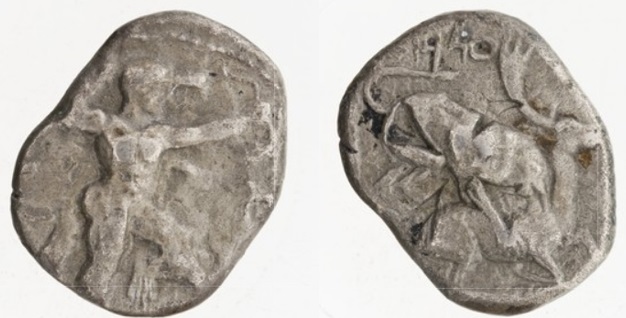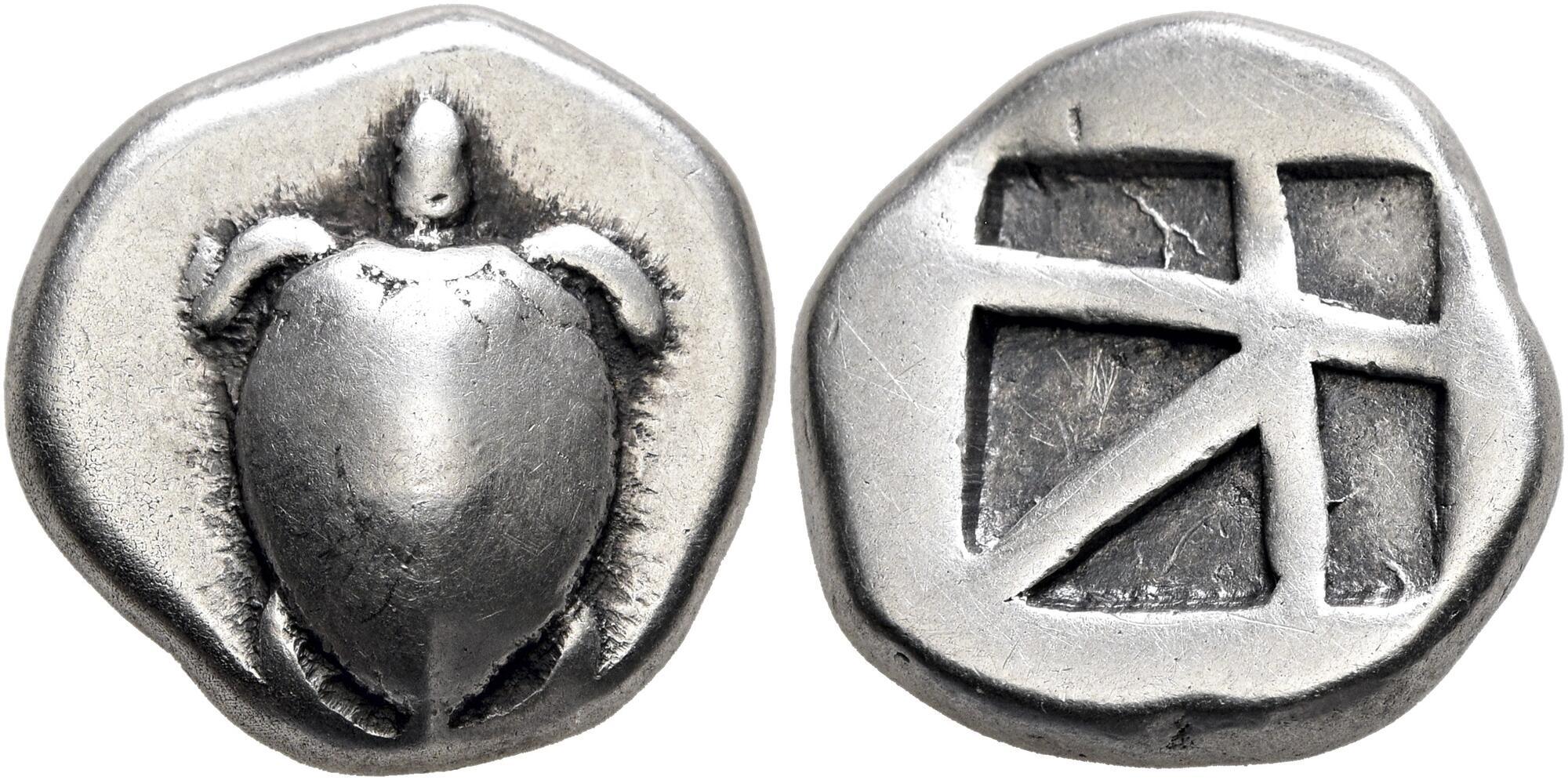1698 - Citium (Baalmelek) (double siglos Heracles/lion & stag) over Aegina (turtle/incuse square) (New York, ANS, 1951.116.81): Difference between revisions
From SILVER
(CSV import-Overstrikes-2022-08-16) |
No edit summary |
||
| (4 intermediate revisions by the same user not shown) | |||
| Line 1: | Line 1: | ||
{{Overstrike | {{Overstrike | ||
|Image overstriking coin=Citium_over_Aegina_New_York, _ANS, _1951.116.81.jpg | |||
|Image reference overstriking coin=http://numismatics.org/collection/1951.116.81?lang=fr | |||
|Image overstruck variety=Aegina 5 parts.jpg | |||
|Image reference overstruck variety=https://pro.coinarchives.com/a/lotviewer.php?LotID=2238447&AucID=5442&Lot=855 | |||
|Museum collection=New York, American Numismatic Society, 1951.116.81 | |Museum collection=New York, American Numismatic Society, 1951.116.81 | ||
|Private collection=C. | |Private collection=Gunther, C. Godfrey coll. | ||
|Obverse description=Herakles in fighting stance to right, wearing lion skin upon his back and tied around neck, holding club overhead in right hand and bow extended before him in left hand. | |Obverse description=Herakles in fighting stance to right, wearing lion skin upon his back and tied around neck, holding club overhead in right hand and bow extended before him in left hand. | ||
|Reverse legend=B'LMLK (in Aramaic) | |Reverse legend=B'LMLK (in Aramaic) | ||
|Reverse legend language=Aramaic | |||
|Reverse description=Lion attacking stag crouching right within incuse square. | |Reverse description=Lion attacking stag crouching right within incuse square. | ||
|Mint=Citium | |Mint=Citium | ||
|Ancient region=Cyprus | |Ancient region=Cyprus | ||
|Authority=Baalmelek II of Citium (king of Citium and Idalium, 5th c. BC) | |Authority=Baalmelek II of Citium (king of Citium and Idalium, 5th c. BC) | ||
|Date from=425 | |Date from=425 BCE | ||
|Date to=400 | |Date to=400 BCE | ||
|Period=Classical | |||
|Metal=Silver | |||
|Weight=10.66 | |Weight=10.66 | ||
|Axis=6 | |Axis=6 | ||
|Denomination= | |Denomination=double siglos | ||
|Coin reference= | |Standard=Persian | ||
|Coin series reference= | |Coin reference=Destrooper-Georgiades 2013, p. 22, n° 41 | ||
|Coin series reference=BMC Crete, n° 35; Zapiti - Michaelidou 2008, n° 5–8; Destrooper-Georgiades 2013, p. 22, n° 41 | |||
|Overstruck obverse description=Turtle (visible on the coin's obverse). | |Overstruck obverse description=Turtle (visible on the coin's obverse). | ||
|Overstruck reverse description=Incuse square (visible on the coin's reverse : mill-sail reverse pattern). | |Overstruck reverse description=Incuse square (visible on the coin's reverse : mill-sail reverse pattern). | ||
|Overstruck mint=Aegina | |Overstruck mint=Aegina | ||
|Overstruck ancient region= | |Overstruck ancient region=Attica | ||
|Overstruck date from=480 BCE | |||
|Overstruck date to=457 BCE | |||
|Overstruck period=Classical | |||
|Overstruck denomination=stater | |Overstruck denomination=stater | ||
|Overstruck standard=Aeginetic | |||
|Coin series reference overstruck=HGC 6, n° 437 ; Meadows (forthcoming), Groups IIa-IIb | |||
|Frequency of overstrikes=frequent | |||
|Level of confidence=sure | |||
}} | }} | ||
Latest revision as of 07:37, 6 November 2023
425 BCE - 400 BCE | B'LMLK (in Aramaic)
Location/history
| Museum collectionMuseum collection: | New York, American Numismatic Society, 1951.116.81 | |
| Private collection(s)Private collection(s) ᵖ: | Gunther, C. Godfrey coll. |
Overstriking coin
Description
| ObverseInscription or printing placed on the obverse.: | Herakles in fighting stance to right, wearing lion skin upon his back and tied around neck, holding club overhead in right hand and bow extended before him in left hand. | ReverseInscription or printing placed on the reverse.: | B'LMLK (in Aramaic) (Aramaic) Lion attacking stag crouching right within incuse square. |
Mint and issuing power
| MintIdentifies the place of manufacture or issue of a numismatic object.: | Citium | Ancient regionAncient region. | Cyprus | Modern countryModern country: Greece | AuthorityIdentifies the issuing power. The authority can be "pretended" when the name or the portrait of X is on the coin but he/she was not the issuing power. It can also be "uncertain" when there is no mention of X on the coin but he/she was the issuing power according to the historical sources: | Baalmelek II of Citium (king of Citium and Idalium, 5th c. BC) |
Chronology
| FromIdentifies the initial date in a range assigned in a numismatic context. 425 BCE toIdentifies the final date in a range assigned in a numismatic context.. 400 BCE | Classical 480-323 BC |
Physical description
| MetalThe physical material (usually metal) from which an object is made.: Silver |
WeightWeight of the numismatic object (in grams). in grams: 10.6610.66 g <br />10,660 mg <br /> | DenominationTerm indicating the value of a numismatic object. Examples: tetradrachm, chalkous, denarius.: double siglos |
AxisDescribes the directional relationship between the obverse and reverse of a numismatic object.: 66 mm <br />0.6 cm <br /> |
| StandardStandard.: Persian | |||
References
| Coin referenceReference of the Coin: | Destrooper-Georgiades 2013, p. 22, n° 41 | Coin series referenceReference to coin series study: | BMC Crete1BMC Crete, n° 35, Zapiti - Michaelidou 20082Zapiti - Michaelidou 2008, n° 5–8, Destrooper-Georgiades 20133Destrooper-Georgiades 2013, p. 22, n° 41 |
Overstruck type
Description
| ObverseInscription or printing placed on the obverse.: | Turtle (visible on the coin's obverse). | ReverseInscription or printing placed on the reverse.: | Incuse square (visible on the coin's reverse : mill-sail reverse pattern). |
Mint and issuing power
| MintIdentifies the place of manufacture or issue of a numismatic object. ᵖ: | Aegina | Ancient regionAncient region. ᵖ | Attica | Modern countryModern country: Greece | AuthorityIdentifies the authority in whose name (explicitly or implicitly) a numismatic object was issued. ᵖ: |
Chronology
| FromIdentifies the initial date in a range assigned in a numismatic context. 480 BCE toIdentifies the final date in a range assigned in a numismatic context.. 457 BCE | Classical 480-323 BC |
Physical description
| DenominationTerm indicating the value of a numismatic object. Examples: tetradrachm, chalkous, denarius. ᵖ: | stater |
StandardStandard. ᵖ: | Aeginetic |
References
| Coin type referenceReference to coin series study ᵖ: | HGC 64HGC 6, n° 437, Meadows (forthcoming)5Meadows (forthcoming), Groups IIa-IIb |
Additional data
| Frequency of overstrikesFrequency of overstrikes: | frequent | Level of confidenceLevel of confidence of the identification: | sure |
| RemarksRemarks: | |||
References
- ^ Wroth, Warwick William (1886), A Catalogue of the Greek coins in the British Museum. vol. X : Crete and the Aegean Islands, London, The Trustees, p. 152, pl. XXIX
- ^ Zapiti, Eleni - Michaelidou, Lefki (2008), Coins of Cyprus : from the collection of the Bank of Cyprus Cultural Foundation, Nicosia, Bank of Cyprus Cultural Foundation, 329 p.
- ^ Destrooper-Georgiades, A. (2013), "Monnaies chypriotes surfrappées des cités-royaumes," in Demetrios Michaelides (ed.), Epigraphy, numismatics, prosopography and History of Ancient Cyprus. Papers in honour of Ino Nicolaou, Studies in Mediterranean Archaeology and Literature PB 179, Uppsala, p. 9-40.
- ^ Hoover, Oliver D. (2010), The Handbook of Greek Coinage Series, volume 6 : handbook of coins of the islands: Adriatic, Iionian, Thracian, Aegean, and Carpathian seas (excluding Crete and Cyprus), sixth to first centuries BC, Lancaster, 358 p.
- ^ Meadows, Andrew (forthcoming), Greek coinage in the Persian Empire: The Malayer 1934 Hoard (IGCH 1790).

